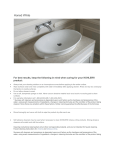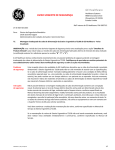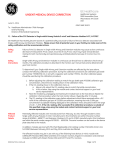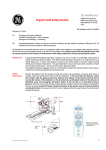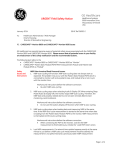Download GE Healthcare
Transcript
GE Healthcare URGENT Field Safety Notice April 2014 Healthcare Systems 9900 Innovation Drive Wauwatosa, WI 53226 USA GEHC Ref# 36096 To: Healthcare Administrator / Risk Manager Chief of Nursing Director of Biomedical Engineering RE: Patient Data Module (PDM) – Top Cover Heat Buildup GE Healthcare has recently become aware of a potential safety issue due to fluid ingress into the top cover assembly which can result in heat buildup. Please ensure that all potential users in your facility are made aware of this safety notification and the recommended actions. Safety Issue Fluid can pass through the seals in the top cover and come into contact with energized contacts in the circuit board. This can result in heat buildup, smoke, and discoloration. This heat buildup could potentially result in thermal injury to a patient or caregiver. Safety Instructions Inspect the top cover for signs of heat buildup or discoloration. If there is evidence of this, discontinue use. In order to minimize the potential risk of injury, do not spray the device with fluid. For cleaning, follow Section 5 of PDM Service Manual. Also do not mount the PDM in a vertical position as noted in Section 3 of the service manual. (see below) Affected Product Details All PDM’s produced from April 2007 through June 2010, encompassing Fiscal Week (FW) 13 2007 through FW 26 2010. Manufactured date can be determined th th from the serial number which is located on the bottom of the unit. The 4 and 5 th th digit are the year, and the 6 and 7 digit are the Fiscal Week. The affected product code is SA3. Example: a unit with serial number SA31035XXXXXX was manufactured in Fiscal Week 35 in 2010. Product Correction GE Healthcare will provide a new top cover at no charge once it is available. We will contact you to arrange for installation of the top cover. Contact Information If you have any questions regarding this notification, please contact Technical Support or your local Service Representative. Please be assured that maintaining a high level of safety and quality is our highest priority. If you have any questions, please contact us immediately per the contact information above. Sincerely, Vice President QARA GE Healthcare Systems Chief Medical Officer GE Healthcare Maintenance Cleaning Precautions Improper cleaning methods can result in degradation of the equipment performance and/or failure. To avoid damage to the equipment: Never use conductive solutions, solutions that contain chlorides, wax, or wax compounds to clean the equipment. Never immerse equipment in any liquid. Never pour or spray any liquid on the equipment or permit fluid to seep into connections or openings. Never autoclave or steam clean the equipment. Never use the following solutions; acetone, Bentadine, ketone, alcohol-based cleaners, sodium salts, abrasive cleaners or any type of Ammonium Chloride such as Dimethyl Benzyl Ammonium Chloride or Quaternary Ammonium Chloride. Never connect the device to a patient until it is thoroughly dry. Permitted cleaning agents Water Mild soap (diluted) Clorox® Bleach (Active ingredient: 5.25% Sodium Hypochlorite-Off the shelf) Mix 10:1 with H2O. Any sodium hypochlorite wipe product that meets the above guidelines. Sagrotan® (dilution 3:100, containing 75 mg tartaric acid per 100 ml solution). Cleaning procedures CAUTION Failure to follow these rules may melt, distort, or dull the finish of the case, blur lettering on the labels, or cause equipment failures. 1. Remove power, all cables and batteries. 2. Close the battery door. 3. Dampen a soft lint-free cloth with one of the permitted cleaning agents. 4. Wring excess liquid from the cloth and wipe the exterior surface. NOTE Contact of disinfectant solutions with metal parts may cause corrosion. Do not damage or bend connector pins when cleaning or drying. Maintenance 5. Allow solution to remain on device for a minimum of one minute or per hospital guidelines. 6. Do not let fluid “pool” around connection pins. If this happens, blot dry with a cotton swab or soft cloth. Shake out excess liquids from connector recesses. 7. Wipe off cleaning solution with a clean, moist cloth. 8. Dry thoroughly with a clean, dry, lint-free cloth and let air dry for at least 30 minutes. Do not apply heat. NOTE Drying times may vary based on the environmental conditions. Storage Remove batteries when the device is not in use, even for short periods of time. Store in a dry well-ventilated area. Hang the device using a holder if available. If leadwires or cables are attached, hang them straight. Do not coil leadwires or cables tightly around the device. Consequences of using improper cleaning product Appearance of waveforms when the device is not connected to a patient, causing false alarms instead of a leads fail alarm and possibly not providing a visual or audible leads fail alarm. Brittle and breaking device case. Overall system performance degradation. Melting, dulling, or distorting the case. Total medical device failure requiring replacement. Unit malfunction. Void warranty. Cleaning products to avoid Cleaning products known to cause the types of problems listed above include, but are not limited to: Sani-Cloth® Wipes Ascepti® Wipes HB Quat® Clorox® Wipes (they do not contain bleach) Over-the-counter detergents (e.g. Fantastic®, Tilex®, etc.). Products that contain active ingredients and solutions similar to these products should also be avoided. Page 3 of 4 Installation WARNING PHYSICAL INJURY—Do not hang articles on the IV pole that are not related to the Patient Data Module’s use. Do not place the Patient Data Module more than 147 cm (58 in) from the floor when mounting on an IV pole with a base not less than 58 cm (23 in) in diameter. WARNING To reduce the ingress of water into the equipment, do not mount the Patient Data Module in a vertical position with the patient cables facing up or down. 482A Mounting options include mounting to a bed headboard or footboard, an IV pole, or a roll stand using one of the docking stations. Mounting kits include all necessary hardware and installation instructions. Page 4 of 4







